If it ain’t broke, don’t fix it. That’s what they say anyway. The Barryvox and Barryvox S(1) have dominated the avalanche transceiver market for the past six-eight years or so, with myself and many others offering that as the definitive suggestion for just about anyone looking for transceiver buying advice.
What made the Barryvox so good?
A few things come to mind, depending on the user. First and foremost, the basic search functionality for a single burial is easy, reliable, and feels foolproof. The same goes for a basic double burial scenario—I feel confident giving a Barryvox to a relatively beginner ski tourist, knowing that even with minimal practice, they will be able to execute a reasonably effective search. There is power in that, as the reality is that not everyone has time or motivation to visit a beacon park or set up practice sessions throughout the season, even if they should.
For the professional user, I’m thinking ski guides, patrollers, forecasters, as well as high-level recreationalists; anyone who is putting in the time to master their beacon skills, the Barryvox has gained widespread adoption (at least in North America). For this user group, just about any modern beacon will be effective in basic single/double burial scenarios, and some may feature faster processing than the Barryvox. For these users, there is a bit more nuance going into their decision about which beacon to purchase. Here, features like an excellent group check, analog audio search tones, pro search features that increase range and allow for a soft-lock (always displaying the strongest signal), and a solid track record of reliability. There are certainly professional users with different preferences, and the argument that the best tool is the one you know how to use best applies; however, many (if not most) seem to have settled on the Barryvox.
Barryvox 2
For winter 2024/2025, Mammut updated the Barryvox series, adding a “2″ to the models (Barryvox 2/Barryvox S2). We were fortunate to receive an S2 for testing last winter. The S2 introduces notable improvements to basic functionality, as well as minor changes to the Pro search capabilities.
Let’s begin with the most useful day-to-day improvement of the new transceiver, the size and weight. As we saw in our first look, the new Barryvoxs are smaller and lighter, which makes a big difference for carrying comfort, especially in a pocket. The slimness and lighter weight are partially attributed to using two versus three AAA batteries (Even more savings using Lithium!), but the unit itself is on a diet as well. I loved this part of the new model, as it felt much less obtrusive in a thigh/hip pocket during day-to-day touring.
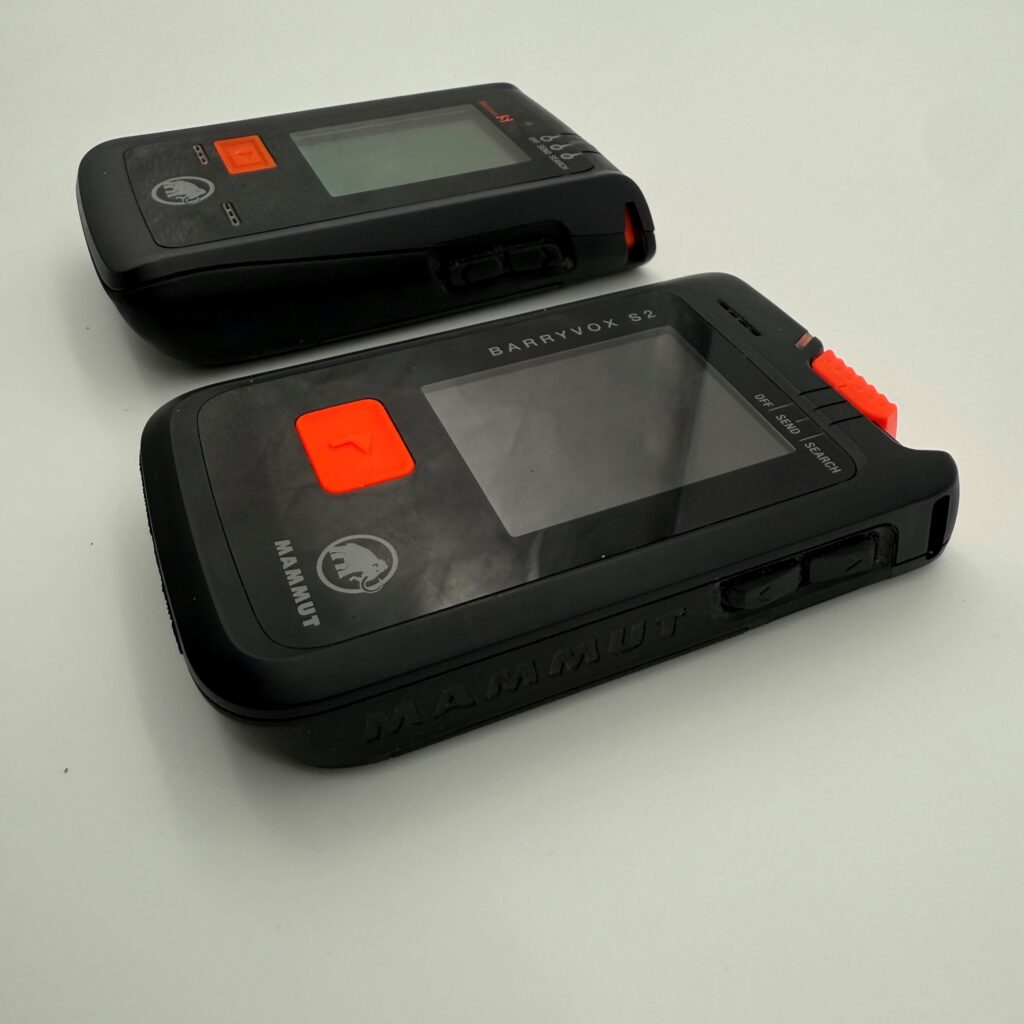
Other day-to-day upgrades include a brighter, more sun-friendly screen as well as Bluetooth connectivity that allows for firmware updates and changing settings via the Mammut App instead of having to click around on a three-button device. Previously, updates had to occur in a shop/dealer equipped with the proper W-Link equipment. I never updated my previous Barryvox/Barryvox S, and I’m sure I’m not alone in that. The app also provides some nice resources and makes it easy to access things like the owner’s manual for referencing features. I found that I had more productive practice/testing sessions when I referenced the owner’s manual in the field before attempting to test alternative search features, in particular, but it was also helpful for simpler things like learning on the spot what a certain symbol may mean on screen during a search or partner check.

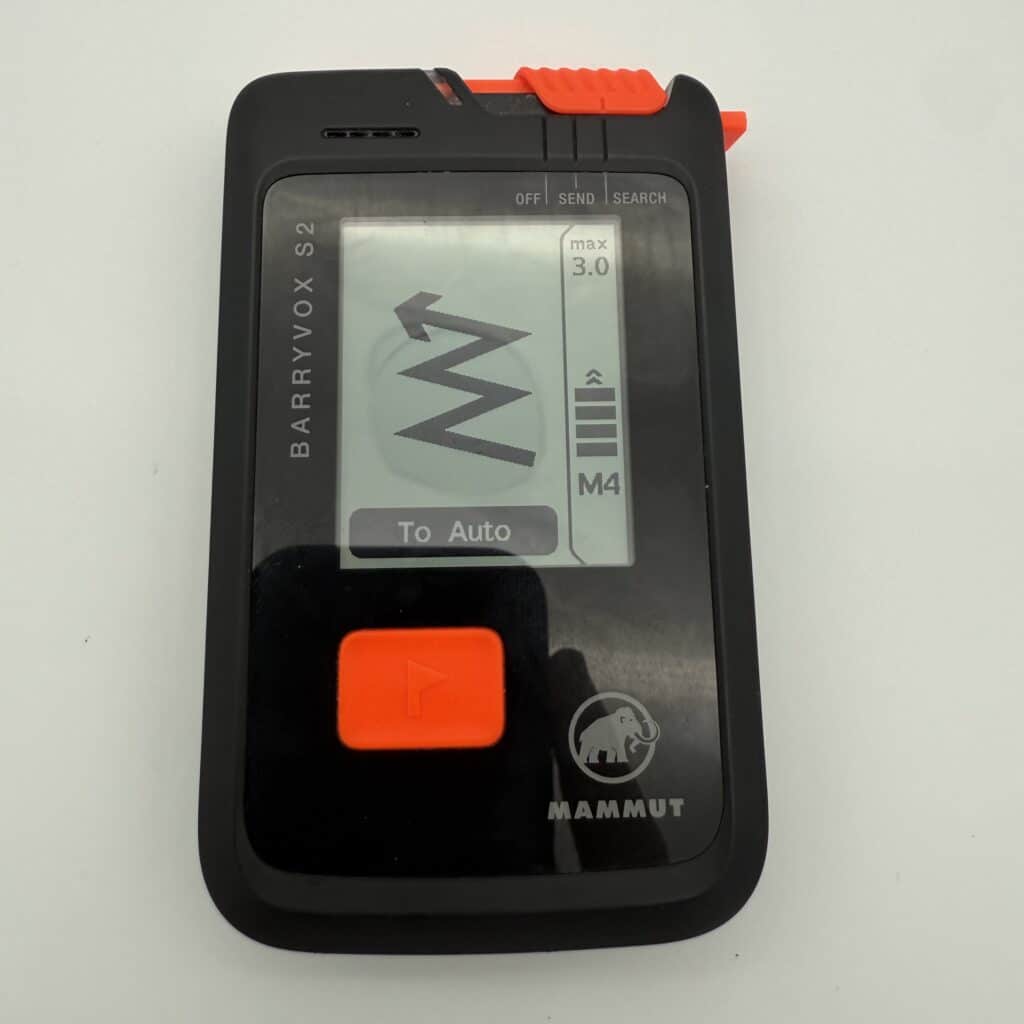
There’s not a ton of changes in the search functionality with the new beacons. Interestingly, a more significant update exists in some locales (such as Canada, France, Italy, the Southern Hemisphere, etc.) with the addition of voice guidance similar to the Ortovox Diract. It seems that existing patents in the U.S., Switzerland, and Austria have led to the disabling of these features in these areas. Given our U.S.-based operation, we couldn’t test these features. Otherwise, basic search functionality remains similar to the previous models. This includes a nominal 70m search strip width, excellent visual search guidance with generally useful on-screen arrows and audio (including the option for analog audio tones), as well as guided or manual fine search options.

Many (myself included) prefer the manual cross method for fine search, rather than the guided option that is the default from Mammut. This is an easy change, but for a trained/experienced rescuer, it can often feel like you are working against the guided mode (e.g., it tells you to go left while your training/intuition tells you to go right). Additionally, many folks are teaching a basic beacon search with no fine search for beginner users these days—leaving the guided search, adding clutter to most users’ search interface. Nonetheless, the Barryvox remains the best I’ve used for plug-and-play, picking up a transceiver for the first time functionality. The flag function also works very reliably, allowing for reliably simple double-burial rescues most of the time with minimal added skill needed. This ought to cover 99% of real-world use, including being an excellent tool for something like a Pro 1 Avalanche Course test.
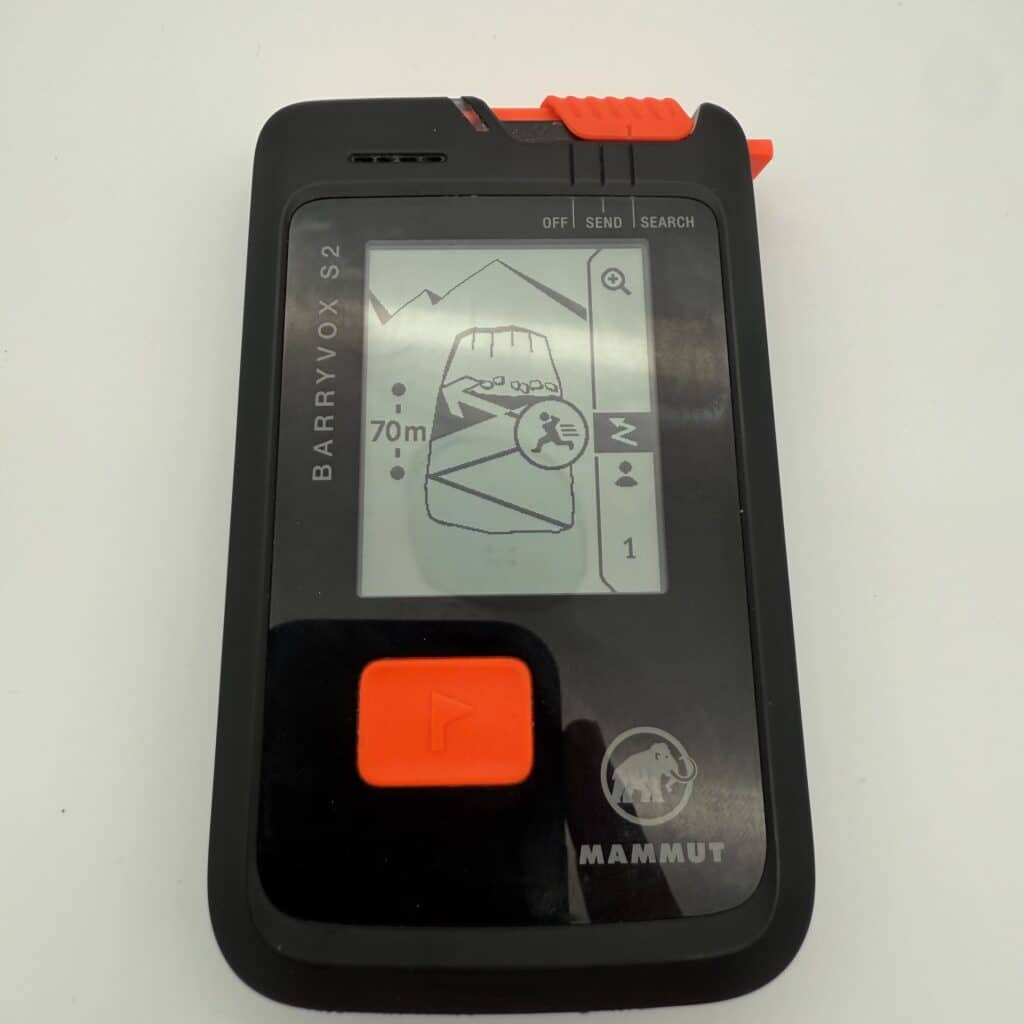

“Search Strip width!” of 20m.
Thankfully, complex multi-burial scenarios are exceedingly rare, especially in the types of ski touring that many of us reading The High Route enjoy. These scenarios come into play more when we get into mechanized access backcountry skiing, where bigger groups are common and the pace/exposure is higher–think heli skiing, cat skiing, or busy lift-accessed backcountry. For professional rescuers, preparing for these situations serves a few purposes; first, if they do happen, efficient beacon searches can be far more complex and require high-level skills and problem solving, and second, having those high-level skills can help us perform more effectively when simpler/common scenarios become complex, such as in close proximity burials. All this is to say that the Barryvox S2 has a robust feature set to help manage these more complex scenarios, which requires some training and know-how to use effectively.
The most notable change in the pro features is the elimination of the “Range +” search mode, which increased the search range to 100m by turning off the screen to reduce EMI and power consumption. Some will miss this feature, which I’m sure would be useful for searching large avalanche paths/debris. “Alternative Search” still exists and can be activated during a search. In essence, this activates a combination of features that are critical for employing more advanced search techniques to solve complex burial problems. The biggest change is from a hard lock + toggle function (where the transceiver locks into a signal until you find and flag it, or toggle to a different one) to a soft lock with adjustable sensitivity (where the strongest signal is always displayed). The adjustable sensitivity takes some getting used to, but a small update to the new model is a max range value displayed above the adjustment bars to give the searcher an idea of their search strip width.

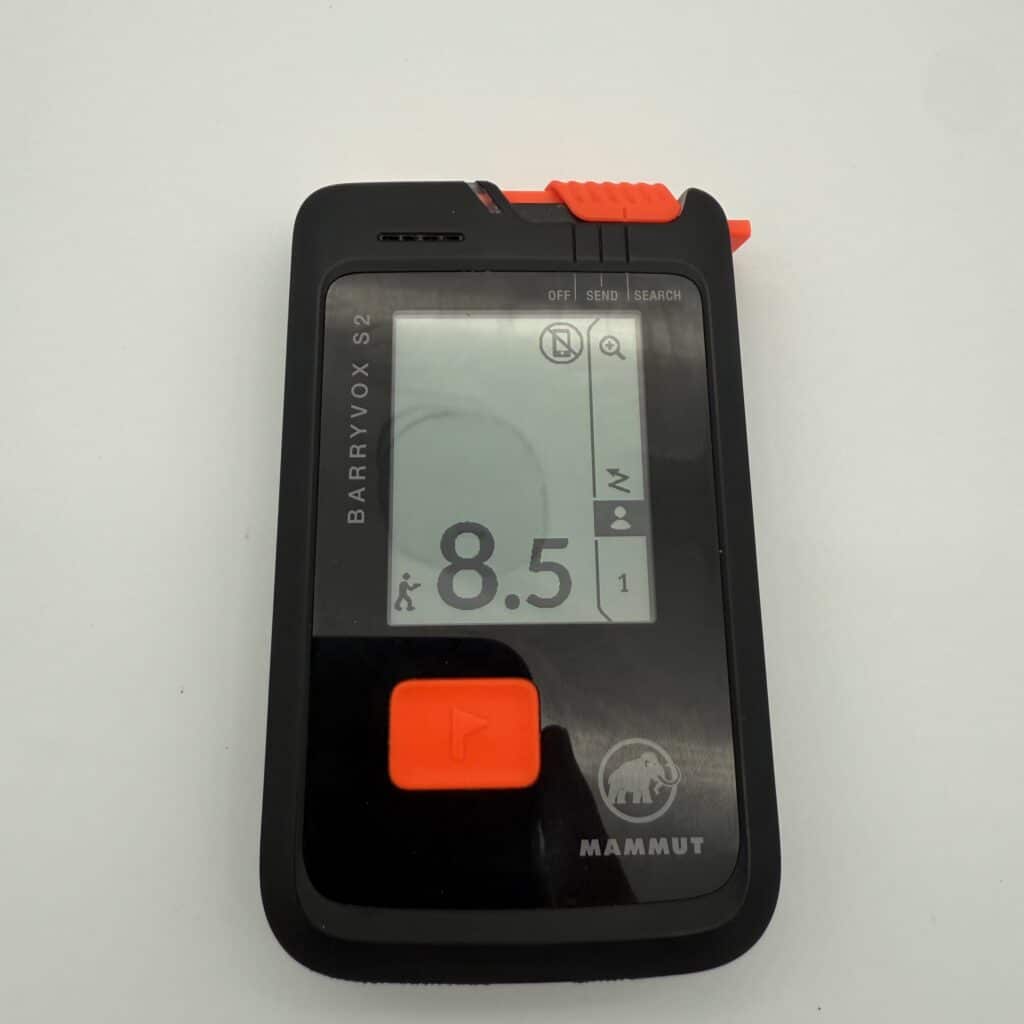
Over the last few years, EMI has been a hot topic in the transceiver and avalanche rescue world. In most ways, Mammut seems to feel that they have already mitigated appropriately for this issue. Their guidance is essentially to continue mitigating interference, as well as using the analog tones to detect interference, then a combination of narrow search strips and alternative search mode when interference can’t be mitigated. Altogether, this aligns well with Mammut’s general story, as seen with the Barryvox: Highly functional, with minimal flash/gimmick. A crossed-out phone appears to alert the searcher to interference, but it doesn’t always register, even with lots of devices close by.
Perhaps the biggest complaint with the previous generation of Barryvoxs was the slow processing time (maybe refresh rate is a descriptive term here). It was easy to make a wrong move, overshoot, or miss something in a frantic feeling rescue situation where the rescuer is trying to move faster than the transceiver can display new information. While in most cases, this can be a good lesson in the valuable mantra of avalanche rescue: “Slow is smooth, smooth is fast.” This lag time could be frustrating in a fine search where you are looking for rapid updates to the tenth of a meter. The lag is particularly noticeable when you overshoot the victim; the screen almost freezes on the lowest number for what feels like an eternity before jumping to the new (often quite a bit higher) number that you have overshot. Long story short, this is a valid complaint, and it isn’t noticeably better in any way on the new unit. Conversely, the Arva Evo BT is significantly quicker in this regard (although it is generally a better competitor for the Barryvox 2, feature-wise). Slow is smooth, smooth is fast.
Competition
It seems like the biggest competition for the Barryvox S2 is likely the Barryvox S. Last season, I didn’t see many of the new beacons in the wild. That is likely attributed to the perfectly good (or great) Barryvox S that many have and still love. A recall on the initial shipments of the new beacons also likely slowed the initial adoption of the new transceivers, although it was quickly identified and corrected. Recalls are a sensitive topic for avalanche gear these days (we covered the recall in greater depth here).
Aside from internal competition, another impressive new transceiver is the Pieps IPS. It was covered here by our late friend Rob Copolillo and has many bells and whistles and is, in Rob’s words, an excellent beacon. However, it suffers from the dark cloud of Pieps/BD’s recent beacon-related woes.
The Arva Neo BT Pro is the only other competitor that offers a similarly robust feature set – I haven’t used the BT Pro personally, but in my limited experience with students/peers, it is susceptible to false signals and feels a bit jumpy/glitchy relative to the slow and steady feel of the Barryvox.
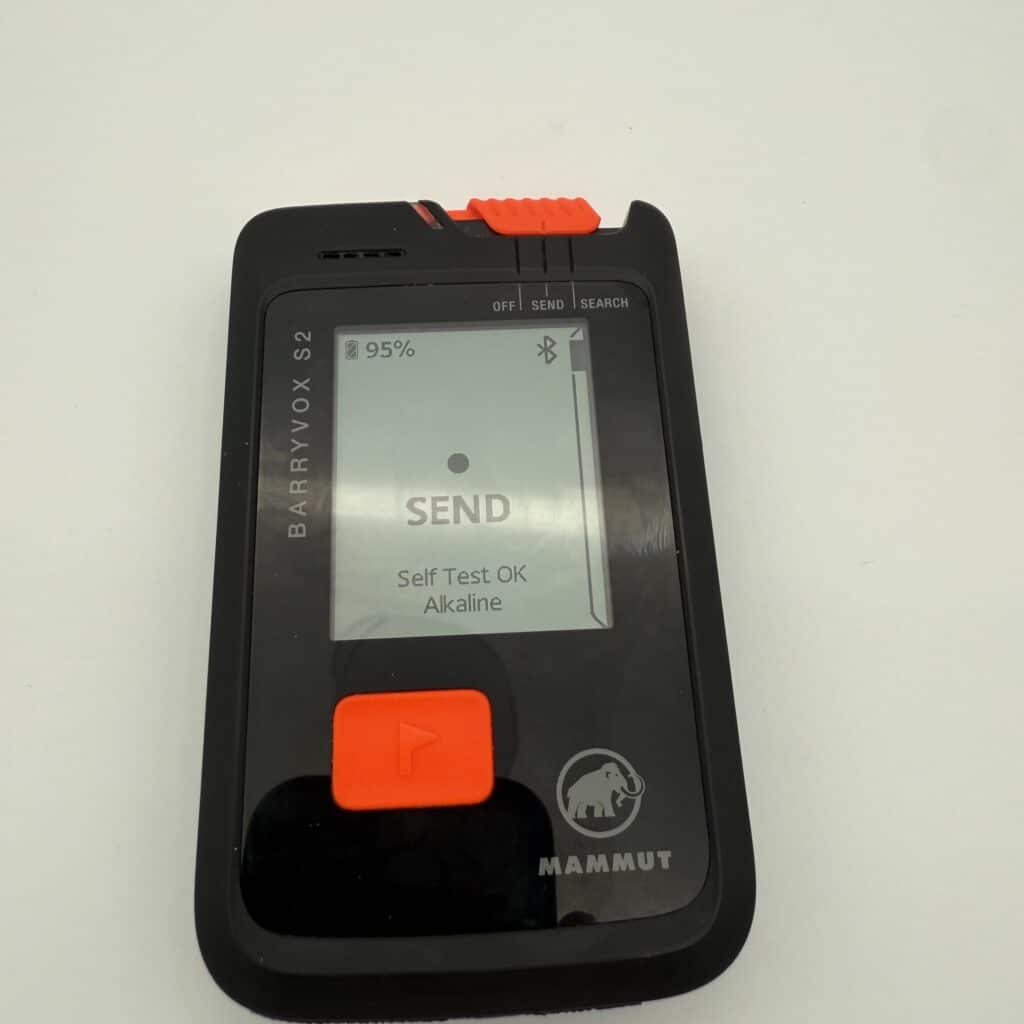
Conclusion
As I stated above, it seems the biggest hurdle to the rapid adoption of Barryvox’s “2 series” is that its predecessors are going strong and remain excellent. I suspect that as folks retire their older models, they will upgrade and enjoy the new model. I reckon that for many, the update isn’t substantial enough to warrant a premature upgrade. While there are small updates to the firmware, the form factor is certainly the most compelling change, followed by the convenience of Bluetooth syncing.
On the whole, Mammut continues to produce an excellent transceiver, and I suspect they will continue to dominate the North American market with these new iterations.






Leave a Reply
You must be logged in to post a comment.